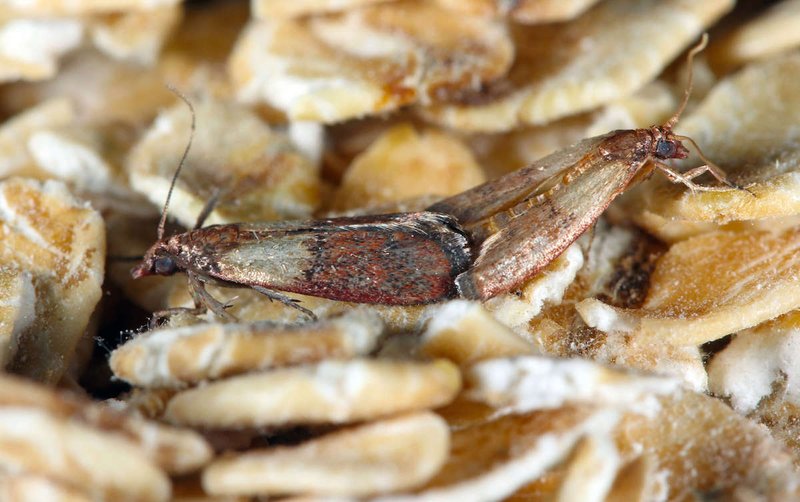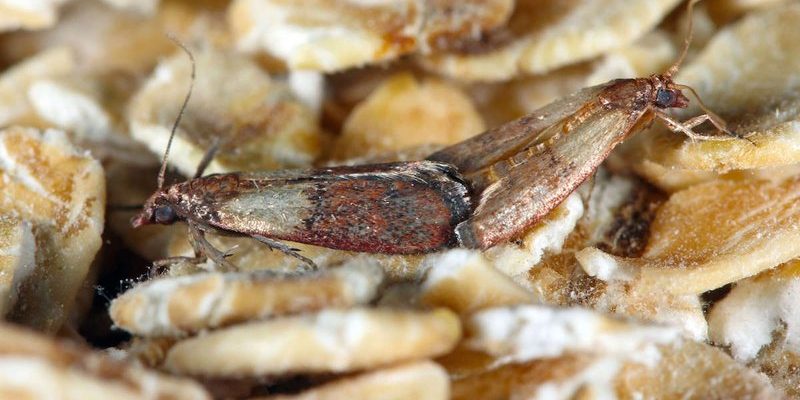
The Indian Meal Moth might be small, but this little creature can create quite a stir in your pantry. Have you ever opened a box of cereal only to find tiny moths fluttering around? If so, you’ve likely encountered these pesky insects. They are one of the most common kitchen pests, often sneaking into homes and making themselves at home in dry goods like flour, rice, and grains. Understanding more about the Indian Meal Moth means you can better protect your food and keep your kitchen moth-free.
So, what exactly is the Indian Meal Moth? Scientifically known as *Plodia interpunctella*, it is a type of moth that belongs to the family Pyralidae. These moths are known for their unique behavior and habits, which can turn your pantry into a breeding ground if you’re not careful. Let’s dive into the world of Indian Meal Moths, exploring their lifecycle, how to spot them, and tips for keeping them at bay.
What Do Indian Meal Moths Look Like?
Indian Meal Moths are quite distinctive in appearance. Adults typically measure about 1/2 inch (13 mm) in length. Their forewings are unique, with a mix of greyish-brown and coppery-orange coloring, which gives them a beautiful yet deceptive look. This coloration helps them blend in with the dried foods they infest, making them harder to spot at first glance. Their hindwings are lighter, usually silvery-grey, and their bodies are slender and elongated.
The larvae, or caterpillars, are also interesting. They’re typically creamy-white to greenish in color and can grow up to around 3/4 inch (19 mm) in length. They have a distinct head capsule that is brownish. You might encounter these larvae crawling around your pantry as they mature, often leaving behind a trail of webbing and frass (a fancy word for bug poop) that can be an unpleasant sign of an infestation.
Table of Key Facts about Indian Meal Moths
| Characteristic | Details |
|---|---|
| Size: | About 1/2 inch (13 mm) in length |
| Habitat: | Primarily indoors, especially in kitchens and pantries |
| Diet: | Grains, nuts, seeds, dried fruit, and stored food products |
| Lifespan: | About 30 days to 1 year, depending on environmental conditions |
| Reproduction: | A female can lay up to 400 eggs in her lifetime |
| Infestation Signs: | Webbing, larvae, and damage to food items |
What is the Lifecycle of an Indian Meal Moth?
The lifecycle of the Indian Meal Moth is fascinating and can be quite rapid. It typically consists of four stages: egg, larva, pupa, and adult moth. A female moth can lay anywhere between 200 to 400 eggs on or near potential food sources. Within a week, these eggs hatch into larvae that begin to feed on the food nearby. This is where things can get messy.
As the larvae grow, they may leave behind webbing and fecal matter, making your pantry look unappealing. They usually take anywhere from two to four weeks to develop into pupae, depending on environmental conditions like temperature and humidity. Once they pupate, they emerge as adult moths. This entire cycle can take anywhere from 30 days to several months, depending on the environment. In warm, humid conditions, they can reproduce quickly, leading to a full-blown infestation.
Where Do Indian Meal Moths Come From?
Indian Meal Moths are believed to originate from the Mediterranean region, but they have spread worldwide over the years. They are particularly common in homes and businesses that store a lot of dry food. Because they can fly and are attracted to light, they can easily find their way indoors through open doors or windows. Once inside, they seek out food sources to lay their eggs.
It’s important to note that Indian Meal Moths can hitch a ride in packaged foods. When buying bulk items or even sealed products, you might unknowingly bring these pests home. They’re experts at finding even the tiniest cracks or openings in food packaging, so proper storage is crucial. Once they’re in, they can quickly take over your pantry, which can be quite a hassle to manage.
How to Identify an Infestation
Spotting an Indian Meal Moth infestation early can make all the difference in managing it effectively. Look for the moths themselves, which are often seen fluttering around your pantry or kitchen, especially in the evening. You might also notice tiny, silken webs in your food containers, as well as larvae crawling around. They’re often found in bags of flour, dried fruits, nuts, or any other stored food products.
Another telltale sign of an infestation is holes or gnaw marks in food packaging. If you open a bag of flour or rice and see fine webbing or clumps of food that look “off,” it’s likely that you have Indian Meal Moths. You might also spot little brown or black droppings, which look like tiny specks of dirt.
Getting Rid of Indian Meal Moths
Dealing with an Indian Meal Moth infestation might sound daunting, but it’s manageable with the right steps. First and foremost, inspect all your dry goods. Discard any infested products immediately. Seal them in a plastic bag to prevent the moths from escaping and making themselves at home elsewhere.
Next, it’s time for a thorough cleaning. Vacuum your pantry shelves and dispose of the vacuum bag to get rid of any eggs or larvae. Wipe down surfaces with a soapy solution or a vinegar-water mix to ensure any residual pests are eliminated. Make sure to check behind and beneath shelves, as moths can often hide in dark corners.
To prevent future infestations, store food in airtight containers made of glass or sturdy plastic. This not only keeps your food fresh but also ensures moths can’t get in. Additionally, consider using moth traps—sticky traps designed to catch male moths. These traps can help monitor your pantry and indicate if any moths are still lingering.
How to Prevent Indian Meal Moths
Prevention is key when it comes to Indian Meal Moths. Start by regularly inspecting your pantry and stored foods. Make it a habit to check packages for signs of damage before bringing new items home. Pay attention to expiration dates, too; older food items are more prone to infestations.
Another effective prevention method is to keep your pantry clean and organized. Wipe up spills promptly and avoid keeping clutter around food storage areas. In addition, rotating your food supplies—using older items first—can help reduce the risk of moths taking up residence in your pantry.
Additionally, consider using natural repellents. Some people find that bay leaves, cedar chips, and even essential oils like peppermint can deter moths. Placing these natural deterrents in your pantry can add an extra layer of protection against these pesky pests. Remember, an ounce of prevention can save you a lot of trouble later!
FAQ
What attracts Indian Meal Moths to my home?
Indian Meal Moths are attracted to stored foods, especially grains, nuts, and dried fruits. They seek out food sources to lay their eggs, which is why they often invade pantries. Their sense of smell is quite keen, allowing them to detect food even from a distance. If you have open packages of food or items nearing their expiration date, they are particularly likely to drop by.
Can Indian Meal Moths harm humans or pets?
While Indian Meal Moths aren’t toxic to humans or pets, their presence can lead to unsanitary conditions in your food stores. Consuming infested food might not be harmful, but it’s certainly unappetizing. If you find moths in your pantry, it’s best to discard any contaminated food to avoid any potential health risks.
How can I tell if the food is infested with Indian Meal Moths?
Infested food often shows signs like webs or clumps, and you may find larvae or even adult moths flying around. The presence of tiny droppings, which look like specks of black or brown dirt, is another indication of an infestation. If you notice any changes in your food’s texture or smell, it’s a good idea to check for pests.
Are Indian Meal Moths active year-round?
Yes, Indian Meal Moths can be active year-round, especially in warm and humid conditions. Their lifecycle is most rapid in these environments, which is why you may see them more often during the warmer months. However, they can thrive indoors in any season, making it essential to maintain good food storage practices throughout the year.
What should I do if I find Indian Meal Moths in my store-bought food?
If you find Indian Meal Moths in store-bought food, discard the infested items immediately. Seal these items in a plastic bag to prevent spreading. Clean your pantry to remove any eggs or larvae, and inspect other items to ensure they aren’t infested. Keeping your pantry well-organized and clean can help prevent future infestations.
Do Indian Meal Moths fly or crawl?
Indian Meal Moths primarily fly, especially at dusk or nighttime. They’re attracted to light and can flutter around your kitchen. However, their larvae crawl and can be found moving through your food products. If you spot adult moths flying, it’s a sign that you may have larvae somewhere in your stored food.
Can I use pesticides to get rid of Indian Meal Moths?
While pesticides can be effective against many pests, they are not the best solution for Indian Meal Moths in food storage areas. Instead, focus on cleaning and physically removing the pests, as this is safer for your food. If you do consider using pesticides, make sure to choose products specifically labeled for use in food storage areas, and always follow the manufacturer’s instructions carefully.
How often should I check my pantry for moths?
It’s a good idea to check your pantry regularly, at least once every few weeks. During your checks, inspect food items carefully and keep an eye out for signs of moths. This proactive approach can help you catch any infestations early, before they become a larger problem.
Are there any natural deterrents for Indian Meal Moths?
Yes, several natural deterrents can help keep Indian Meal Moths at bay. Bay leaves, cedar chips, and essential oils like peppermint can be effective when placed in your pantry. These natural options not only help deter moths but can also add a pleasant aroma to your food storage areas.
What should I do if I still see Indian Meal Moths after cleaning?
If you continue to spot Indian Meal Moths after thoroughly cleaning your pantry, it may be necessary to redo your inspection. Check all food items and packages closely for any hidden larvae or moths. You might also consider using traps specifically designed to catch Indian Meal Moths. If you’re unable to control the infestation, reaching out to a pest control professional can provide you with more targeted solutions.

